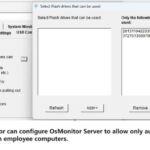The application and research of SVM in anomaly detection and analysis in network behavior management systems have been extensive. By continuously improving and optimizing SVM algorithms, researchers can enhance the accuracy, efficiency, and diversity of anomaly detection, thereby enhancing the security and reliability of network behavior management systems.
SVM plays an important role in anomaly detection and analysis in network behavior management systems. Here are some applications and research directions of SVM in this field:
- Anomaly detection: SVM can establish a boundary by training data to distinguish normal network behavior from abnormal behavior. By identifying and classifying abnormal patterns in network behavior, SVM can effectively detect potential network attacks, malicious activities, or other anomalies.
- Feature selection and extraction: SVM can also be used for selecting and extracting the most relevant features in network behavior management systems. By selecting features with high predictive power, SVM can improve the accuracy and efficiency of anomaly detection.
- Parameter optimization: The performance and accuracy of SVM depend greatly on the selection of its parameters. Therefore, researchers can improve the anomaly detection capability of SVM in network behavior management systems by optimizing its parameter settings. This can involve choosing suitable kernel functions, adjusting regularization parameters, etc.
- Multiclass classification: Anomaly detection in network behavior management systems often involves the classification of multiple categories. SVM has the ability for multiclass classification and can classify network behavior into different abnormal categories. Researchers can study and improve SVM's multiclass classification algorithms to enhance the granularity of anomaly detection in network behavior management systems.
- Integration with other techniques: SVM can be combined with other machine learning algorithms and techniques to further improve the performance and effectiveness of network behavior management systems. For example, combining SVM with deep learning methods can provide higher representational capacity and complexity.
The application research of SVM in network behavior management systems includes the following aspects:
- Security event classification: SVM can be used to classify security events in network behavior. By using labeled training data, SVM can learn and establish a model for categorizing network behavior into different security event types, such as network attacks, intrusions, or malicious software.
- Anomaly behavior detection: SVM can also be used to detect anomalous behavior in network behavior management systems. By training on normal network behavior, SVM can identify and label behavior that deviates from the learned patterns, thereby helping to discover potential abnormal activities and security threats.
- Event prediction and warning: SVM can predict future security events by analyzing historical network behavior data. By training models and utilizing time-series data, SVM can provide warnings and predictions about potential abnormal events, helping network administrators take timely measures to mitigate threats.
- Threat intelligence analysis: SVM can be combined with threat intelligence data to analyze and identify threat activities in network behavior. By correlating and analyzing threat intelligence with network behavior data, SVM can help identify potential sources and patterns of threats.
- System optimization: Researchers can also apply SVM to optimize the performance and efficiency of network behavior management systems. By adjusting SVM parameters, using kernel function optimization, and other techniques, the accuracy of anomaly detection and the overall performance of the system can be improved.
In summary, SVM has a wide range of applications and research in anomaly detection and analysis in network behavior management systems. Through continuous research and innovation, SVM plays a crucial role in enhancing the security and reliability of network behavior management systems, by improving the accuracy, efficiency, and effectiveness of anomaly detection.
About OsMonitor:
The mission of OsMonitor is to create a Windows computer system tailored for work purposes, effectively regulating employee computer behavior. It enables employers to understand what employees are doing each day, monitoring every action, including screen activity and internet usage. Additionally, it restricts employees from engaging in specific activities such as online shopping, gaming, and the use of USB drives.
OsMonitor, designed purely as software, is remarkably user-friendly and requires no additional hardware modifications. A single management machine can oversee all employee computers. As a leading brand in employee computer monitoring software with over a decade of successful operation, OsMonitor has rapidly captured the global market with its minimal file size and excellent cost-effectiveness compared to similar software. At this moment, thousands of business computers worldwide are running OsMonitor daily.


































